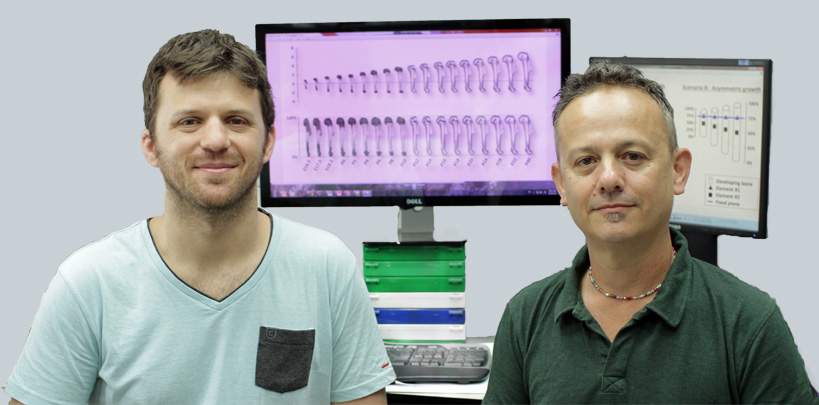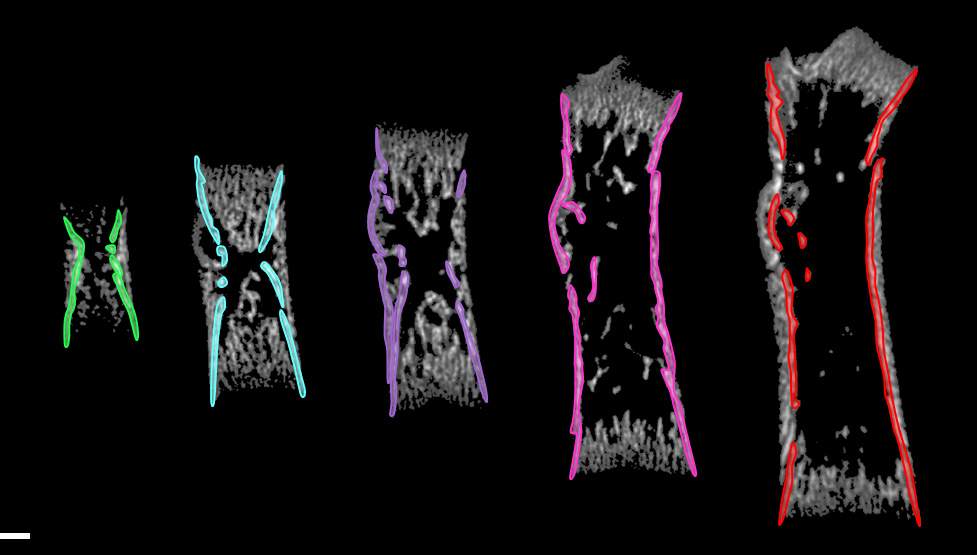As the body grows, its organs must retain their shape in order to function well. In a study reported recently in PLoS Biology, Weizmann Institute scientists have discovered a surprising mechanism that enables the bones in the limbs to maintain the same proportions throughout the growth process.

Arm and leg bones have various asymmetrical protrusions that allow the attachment of muscles and joints. Since bones are rigid structures that in the course of the growth elongate only from their ends, it had been unclear how their protrusions always end up in the right locations: For example, a bump in the embryo that is, say, 10% of the total bone’s length away from the end, ends up in the exact same spot relative to the length of the bone in the adult. A prevalent hypothesis, proposed more than 60 years ago, states that bone protrusions are continuously destroyed and rebuilt in the right place – a process known as drift.
To test this hypothesis,
Prof. Elazar Zelzer and graduate student Tomer Stern of the Molecular Genetics Department performed three-dimensional computer tomography to obtain images of the long bones of mice throughout the growth process from embryo to adult, ultimately compiling a large database of images. They then developed a computer algorithm that helped them align these images, which had been taken from different angles, so that they could be compared and analyzed. Zelzer and Stern found that even though the bones grew more than five times in length during the animal’s development, they continuously maintained their shape. But surprisingly, the protrusions drifted very rarely or not at all. Rather, bone shape was maintained by a completely different mechanism.

The scientists discovered that the bone grows at different rates at its two ends throughout the animal’s development, and that the ratio of these two rates is such that the protrusion always stays in the same place relative to the rest of the bone: When the protrusion is close to one end of the bone, that end grows more slowly, whereas the one further away from the protrusion grows more quickly. For example, if the protrusion is at a spot distanced from the end by 10% of the bone’s entire length, this end will grow more slowly, whereas the one removed from the protrusion by 90% of the bone’s length will grow faster.
Differential Rates
In this manner, no matter how much the bone increases in size, the protrusion always maintains its relative location. And each bone has its own ratio of growth at both ends. This growth-ratio mechanism ensures that the protrusions are at the right place at almost any given moment; only rarely do they need to drift. In fact, through mathematical analysis, the scientists showed that the newly discovered mechanism minimizes drift, which is an energy-consuming process.
In addition to being economical, this mechanism probably ensures that throughout the growth of the organism, bones keep their optimal shape so they can withstand the increasing load of body weight. The scientists believe such growth is controlled by a combination of genetic and mechanical factors, which remain to be investigated. Taking part in the study were Rona Aviram, Dr. Chagai Rot and Dr. Amnon Sharir of Prof. Zelzer’s lab, as well as Tal Galili of Tel Aviv University, Noga Kalish Achrai and Prof. Ron Shahar of the Hebrew University of Jerusalem and Prof. Yosi Keller of Bar-Ilan University.
Prof. Elazar Zelzer’s research is supported by the David and Fela Shapell Family Foundation INCPM Fund for Preclinical Studies; the Jeanne and Joseph Nissim Foundation for Life Sciences Research; the Irving and Dorothy Rom Charitable Trust; the Bernard and Audrey Jaffe Foundation; and the estate of Georges Lustgarten.

